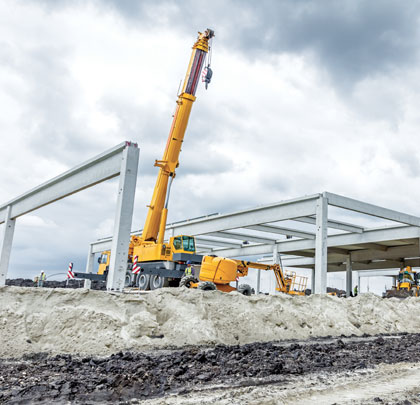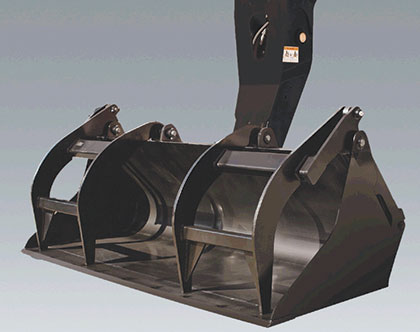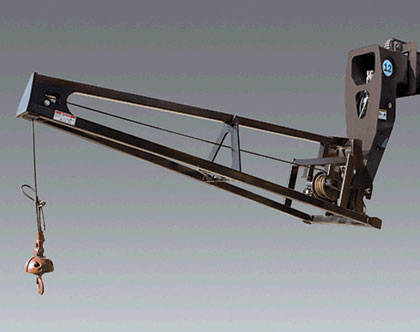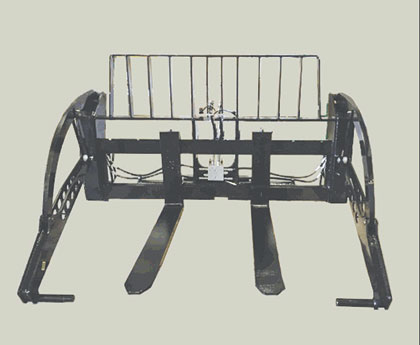When materials need to be moved around a jobsite or through a facility, telehandlers are often the go-to piece of equipment for contractors. The versatility of these machines allows operators access to a variety of jobsites and assignments. Unlike forklifts, which rely on a vertical mast to move loads, telehandlers feature telescoping booms, allowing them to deliver materials to heights of 65 feet or higher and carry loads weighing as much as 75,000 pounds or more.
The versatility of these machines is enhanced by a variety of attachments that fit on the end of the boom. Understanding the nature of the work to be accomplished and the capabilities of the various attachments is critical to a safe and efficient jobsite. This means knowing whether a load needs to be picked or placed. Does the job require loose material to be scooped or a load suspended? Does the operator need to grapple loose material or pipes? Answering these questions will help contractors select the appropriate size and type of attachment.
THE JOB OF A BUCKET
Attachments generally fall into four categories: buckets, carriages, truss booms/lift hooks, and specialty attachments. Buckets are a good choice when a job requires loose material to be loaded and moved. For example, a non-powered general-purpose bucket can be used to load dirt, mulch, gravel, or any other bulk material, while a powered grapple bucket is helpful for non-uniform loads that are awkward to capture in the bucket without the use of grapple arms. These arms also help maintain the load in the bucket during transporting and disposal of the contents.
The multi-purpose bucket is suited for a variety of applications. With its split bucket design, it can be used for loading, carrying, and dumping. It can also be used as a grapple for handling odd-shaped objects or for dozing, leveling, and spreading material with the clamshell open. It is important to note that all buckets are intended for non-excavating applications.
CARRIAGE ATTACHMENTS
Carriage attachments perform numerous tasks and come in a variety of widths and functionality, making them the most popular choice among telehandler attachments. Contractors who need to transport or place a load that requires no special features often choose a standard carriage to get the job done. With added features, the carriage can perform and provide positioning of the load to suit the end users’ needs. For example, the side tilt carriage is able to position a load properly for transport across uneven terrain and pick or place loads that are not on a level surface. Another option is the side swing carriage, which provides offset placement of a load in angles from 50 to 90 degrees each side from center. This is useful when the machine is unable to provide a direct path to a load due to a work environment that offers limited space to operate.
Contractors can also select a fork positioning carriage, which provides a powered means to situate the forks at the correct spread for palletized loads without the operator having to leave the cab. Side shifting carriages are also available, offering the ability to shift the entire carriage and fork either direction. This is useful if positioning the machine side-to-side is not possible when picking up a load, or if lateral placement of a load is necessary.
TRUSS BOOMS AND LIFT HOOKS
Another attachment that enhances telehandler versatility is the truss boom, which can provide a multitude of solutions to jobsite challenges. The truss boom can increase the capabilities of a vehicle by providing increased reach and, in some cases, increased height of the suspended load. The boom is available in various lengths, from a simple boom mounted lift hook to a 15-foot truss boom. Most come in fixed lengths, but adjustable truss booms are also available to vary the reach of the load. Additional variations of coupler or fork-mounted truss boom and hooks expand the options available to contractors. In those applications where up and down movement of a boom is not possible, a truss boom equipped with a winch offers a solution, allowing the operator to raise and lower the suspended load in a linear direction and into tight spots.
SPECIALTY ATTACHMENTS
Contractors also turn to a wide variety of specialty attachments to meet specific jobsite applications. Some of the more popular specialty attachments available to them today include fork-mounted work platforms, pipe grapples, sweepers, augers, and trash hoppers. The fork-mounted work platform can be installed on a carriage and used to lift personnel for those jobs that require hands-on work at heights. Pipe grapples are popular in the oil and gas industry, where they are used to grapple and transport pipes and poles of especially long lengths.
Contractors will also find sweeper attachments useful for jobsite cleanup and collecting debris into a hopper for disposal. If a job requires an operator to “punch” holes for posts or poles, an auger is the ideal implement to accomplish the task. An auger bit is available in diameters ranging from 6 to 36 inches.
Fork-mounted trash hoppers are another specialty attachment for telehandlers. Equipped with a feature that allows the operator to empty the hopper’s contents without leaving the comfort of the telehandler cab, this accessory is a valuable addition to a telehandler that helps keep jobsites clean and safe.
ATTACHMENT KNOWLEDGE KEY
Telehandler attachments offer contractors a variety of solutions to accomplish a wide array of tasks. From picking and placing palletized loads, to bucket work and suspending loads, the attachments available to contractors equip telehandlers to tackle multiple assignments across many different industries. To use them most effectively, however, requires contractors to become familiar with each of the attachment options available to them. By matching the right attachment to the task at hand, contractors can maximize the benefits of the telehandler and contribute to a safe, efficient, and productive jobsite.
About the Author:
John Boylan is a senior project engineer with JLG Industries, Inc. For more information about JLG Industries and its products, visit www.jlg.com.
_________________________________________________________________________
Modern Contractor Solutions, February 2018
Did you enjoy this article?
Subscribe to the FREE Digital Edition of Modern Contractor Solutions magazine.






